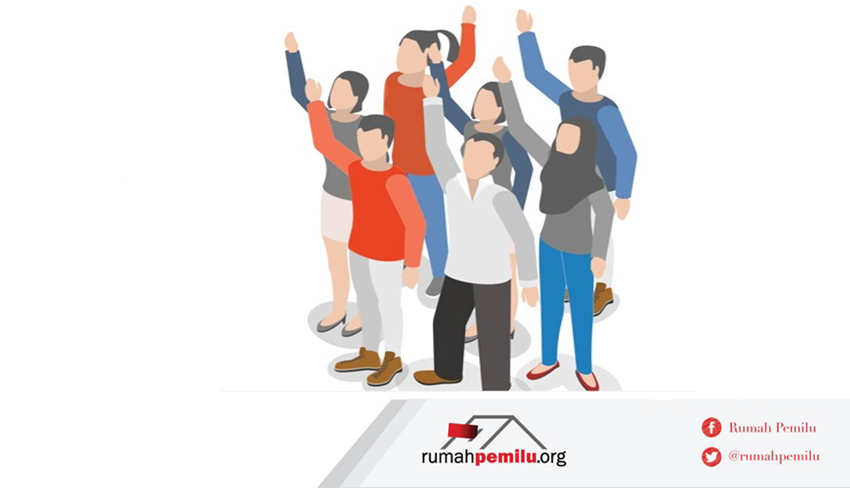The phenomenon that drove political parties into government coalition needs to be carefully examined; our concerns are not of big and transactional politics in the government, but on the weakening of opposition parties in parliament.
Maybe this time we know Red and White Coalition (KMP) as a coalition of parties expressly declare themselves as Opposition, too naive if we only know KMP as the culprit tends to be controversial, in fact firmness is a positive thing that KMP still maintain check and balance on the government.
It was started by the joining of PPP in the Great Indonesia Coalition (KIH) and in return the government was to provide seat of Minister of Religion to PPP. Then PAN which finally came close to Jokowi said that PAN will get two minister seats minister in cabinet reshuffle II in return. Said of Aziz subekti, a PAN politician eventually led to a polemic to dictate president. Then based on Rapimnas Golkar party resulted in the decision that Golkar join the Jokowi-JK government coalition. If it is like that, then whatâ€s the use of Gerindra and PKS that remain consistent as an opposition party because minimum forces are not useful in DPR.
A myriad of reasons could have been raised by these parties but of course they make public disgusted with their inconsistencies, featuring political lust for power and interests of the peopleâ€s interests scattered on the road. Instead of adding “nutrition†to the running of better government, these parties†joints make the government inefficient. Thatâ€s presumably Indonesiaâ€s current political picture; noisy with the fight for power and then forget their obligation as representatives of the people.
The importance of checks and balances
It is said that once Parliament or DPR just work as a “stamper” of every policy decided by government, the power of the President is so great to unfold so as to fall into the power of tyranny. That would picture the relationship between the President and the Parliament on the new order, in line with the reform that is also in conjunction with the 1945 amendment, powers of the President began to be cut and “handed over†to DPR. Presidential system wanted to be emphasizes instead shifted into semi-presidential or semi-parliamentary, the shift was not simply and solely due to the dominance of DPR as it is today.
Continuity between the three pillars of the state with reference to the concept of Triaspolitica in a democratic country, the strengthening of DPR together with reformation were solely for the sake of the birth of the mechanism of checks and balances between state institutions to create a political stability. As a result of the power of DPR, consequently the strength of DPR seems to be items that must be contested in order to serve the interests of their own affairs.
Chiefs of TNI and Polri used to be directly appointed by the President, but now it is up to DPR even added with the authority of selecting the leadership of state institutions such as KPK, KPU, BPK and others. Of course if it is not transparent and accountable it could affect the political reciprocation and tends on corruption. This great power, made DPR propose impeachment against the president to Peopleâ€s Consultative Assembly, as happened to President Gus Dur.
The dominance of DPR is a frightening specter for the president in carrying out his/her official duties because DPR seems to hamper government performance. DPR, which in reality is the representative body of a political party, is very strong with transactional politics of each party. However, on the contrary if the government side is very strong it is also not good for the running of the government, because government can issue non-pro people policy and surely the policy will run smoothly if government coalition dominates the parliament. Although there is a judicial body that has the authority to question the appropriateness of a policy through a lawsuit filed by parties who feel aggrieved, this is considered inefficient and led to not optimal governmentâ€s performance.
Dilemma of a coalition party
Learning from the experience of previous administrations, in the era of President Abdurrahman Wachid, relationship between the government and the House of Representatives did not work in harmony. DPR was troublesome for government and in fact Gus Dur was impeached, at that moment, the majority of the parliaments were on the government side. This showed that political parties could not be the benchmark of how strong a president in parliament. Similarly, in the era of President Megawati, all political parties supported the government, but the relationship between President and Parliament was also not harmonious. Often occurred, interpellation against the president but at that time the president never attended in person. It might be that we did not know the term of Coalition and Opposition so that the policy is difficult to be guessed, and it has been a dilemma for political Parties until today.
As time went by, SBY administration began to show that the government and the Opposition Coalition Party. At that time the government coalition was able to control a majority in Parliament, but it also did not guarantee that the government coalition remained solid. Sometimes there were parties in the coalition circles naughty so they often issued a different statement. And predictions on Jokowi administration this time, the possibility of coalition parties will do the same and does not show any union. Of course, all of this is proof that party political interests are above everything. Then where are the interests of the people?
DELLY FERDIAN
Political Science Student of UNAND, actively involved in JEMARI Sakato NGO
Translated by SL
 Rumah Pemilu Indonesia Election Portal
Rumah Pemilu Indonesia Election Portal


